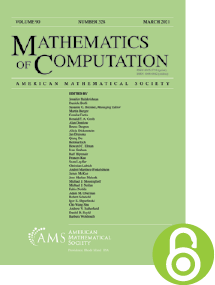$\mathbb {Q}$-Curves, Hecke characters and some Diophantine equations
HTML articles powered by AMS MathViewer
- by Ariel Pacetti and Lucas Villagra Torcomian HTML | PDF
- Math. Comp. 91 (2022), 2817-2865 Request permission
Abstract:
In this article we study the equations $x^4+dy^2=z^p$ and $x^2+dy^6=z^p$ for positive square-free values of $d$. A Frey curve over $\mathbb {Q}(\sqrt {-d})$ is attached to each primitive solution, which happens to be a $\mathbb {Q}$-curve. Our main result is the construction of a Hecke character $\chi$ satisfying that the Frey elliptic curve representation twisted by $\chi$ extends to $Gal_\mathbb {Q}$, therefore (by Serre’s conjectures) corresponds to a newform in $S_2(\Gamma _0(n),\varepsilon )$ for explicit values of $n$ and $\varepsilon$. Following some well known results and elimination techniques (together with some improvements) our result provides a systematic procedure to study solutions of the above equations and allows us to prove non-existence of non-trivial primitive solutions for large values of $p$ of both equations for new values of $d$.References
- Michael A. Bennett and Imin Chen, Multi-Frey $\Bbb Q$-curves and the Diophantine equation $a^2+b^6=c^n$, Algebra Number Theory 6 (2012), no. 4, 707–730. MR 2966716, DOI 10.2140/ant.2012.6.707
- Wieb Bosma, John Cannon, and Catherine Playoust, The Magma algebra system. I. The user language, J. Symbolic Comput. 24 (1997), no. 3-4, 235–265. Computational algebra and number theory (London, 1993). MR 1484478, DOI 10.1006/jsco.1996.0125
- Michael A. Bennett, Jordan S. Ellenberg, and Nathan C. Ng, The Diophantine equation $A^4+2^\delta B^2=C^n$, Int. J. Number Theory 6 (2010), no. 2, 311–338. MR 2646760, DOI 10.1142/S1793042110002971
- J. E. Cremona, Hyperbolic tessellations, modular symbols, and elliptic curves over complex quadratic fields, Compositio Math. 51 (1984), no. 3, 275–324. MR 743014
- Henri Darmon, Rigid local systems, Hilbert modular forms, and Fermat’s last theorem, Duke Math. J. 102 (2000), no. 3, 413–449. MR 1756104, DOI 10.1215/S0012-7094-00-10233-5
- Henri Darmon and Andrew Granville, On the equations $z^m=F(x,y)$ and $Ax^p+By^q=Cz^r$, Bull. London Math. Soc. 27 (1995), no. 6, 513–543. MR 1348707, DOI 10.1112/blms/27.6.513
- Henri Darmon and Loïc Merel, Winding quotients and some variants of Fermat’s last theorem, J. Reine Angew. Math. 490 (1997), 81–100. MR 1468926
- Luis Dieulefait and Jorge Jiménez Urroz, Solving Fermat-type equations via modular $\Bbb Q$-curves over polyquadratic fields, J. Reine Angew. Math. 633 (2009), 183–195. MR 2561200, DOI 10.1515/CRELLE.2009.064
- Jordan S. Ellenberg, Galois representations attached to $\Bbb Q$-curves and the generalized Fermat equation $A^4+B^2=C^p$, Amer. J. Math. 126 (2004), no. 4, 763–787. MR 2075481, DOI 10.1353/ajm.2004.0027
- Jordan S. Ellenberg, On the error term in Duke’s estimate for the average special value of $L$-functions, Canad. Math. Bull. 48 (2005), no. 4, 535–546. MR 2176151, DOI 10.4153/CMB-2005-049-8
- F. Golfieri, A. Pacetti, and L. Villagra Torcomian, On the equation $x^2+dy^6=z^p$ for square-free $1\le d\le 20$, 2021. arXiv:2109.07291
- Angelos Koutsianas, On the generalized Fermat equation $a^2+3b^6=c^n$, Bull. Hellenic Math. Soc. 64 (2020), 56–68. MR 4097424
- Daniel Sion Kubert, Universal bounds on the torsion of elliptic curves, Proc. London Math. Soc. (3) 33 (1976), no. 2, 193–237. MR 434947, DOI 10.1112/plms/s3-33.2.193
- Chandrashekhar Khare and Jean-Pierre Wintenberger, Serre’s modularity conjecture. II, Invent. Math. 178 (2009), no. 3, 505–586. MR 2551764, DOI 10.1007/s00222-009-0206-6
- Chandrashekhar Khare and Jean-Pierre Wintenberger, Serre’s modularity conjecture, Proceedings of the International Congress of Mathematicians. Volume II, Hindustan Book Agency, New Delhi, 2010, pp. 280–293. MR 2827796
- The LMFDB Collaboration, The L-functions and modular forms database, 2022, http://www.lmfdb.org, Accessed 4 January 2022.
- PARI Group, Univ. Bordeaux, PARI/GP version 2.12.2, 2019, http://pari.math.u-bordeaux.fr/.
- A. Pacetti and L. Villagra Torcomian, $\mathbb {Q}$-curves, Hecke characters and some Diophantine equations II, Publ. Mat. (2022), To appear.
- Jordi Quer, $\textbf {Q}$-curves and abelian varieties of $\textrm {GL}_2$-type, Proc. London Math. Soc. (3) 81 (2000), no. 2, 285–317. MR 1770611, DOI 10.1112/S0024611500012570
- K. A. Ribet, On modular representations of $\textrm {Gal}(\overline \textbf {Q}/\textbf {Q})$ arising from modular forms, Invent. Math. 100 (1990), no. 2, 431–476. MR 1047143, DOI 10.1007/BF01231195
- Kenneth A. Ribet, Abelian varieties over $\bf Q$ and modular forms, Modular curves and abelian varieties, Progr. Math., vol. 224, Birkhäuser, Basel, 2004, pp. 241–261. MR 2058653, DOI 10.1007/978-3-0348-7919-4_{1}5
- Jean-Pierre Serre, Corps locaux, Publications de l’Université de Nancago, No. VIII, Hermann, Paris, 1968 (French). Deuxième édition. MR 0354618
- Samir Siksek, The modular approach to Diophantine equations, Explicit methods in number theory, Panor. Synthèses, vol. 36, Soc. Math. France, Paris, 2012, pp. 151–179 (English, with English and French summaries). MR 3098134
- Joseph H. Silverman, The arithmetic of elliptic curves, 2nd ed., Graduate Texts in Mathematics, vol. 106, Springer, Dordrecht, 2009. MR 2514094, DOI 10.1007/978-0-387-09494-6
- J. Tate, Algorithm for determining the type of a singular fiber in an elliptic pencil, Modular functions of one variable, IV (Proc. Internat. Summer School, Univ. Antwerp, Antwerp, 1972) Lecture Notes in Math., Vol. 476, Springer, Berlin, 1975, pp. 33–52. MR 0393039
Additional Information
- Ariel Pacetti
- Affiliation: Center for Research and Development in Mathematics and Applications (CIDMA), Department of Mathematics, University of Aveiro, 3810-193 Aveiro, Portugal
- MR Author ID: 759256
- Email: apacetti@ua.pt
- Lucas Villagra Torcomian
- Affiliation: FAMAF-CIEM, Universidad Nacional de Córdoba. C.P.: 5000 Córdoba, Argentina
- ORCID: 0000-0003-2525-5694
- Email: lucas.villagra@unc.edu.ar
- Received by editor(s): January 13, 2022
- Received by editor(s) in revised form: April 20, 2022
- Published electronically: August 4, 2022
- Additional Notes: The first author was partially supported by FonCyT BID-PICT 2018-02073 and by the Portuguese Foundation for Science and Technology (FCT) within project UIDB/04106/2020 (CIDMA). The second author was supported by a CONICET grant.
- © Copyright 2022 American Mathematical Society
- Journal: Math. Comp. 91 (2022), 2817-2865
- MSC (2020): Primary 11D41, 11F80
- DOI: https://doi.org/10.1090/mcom/3759
- MathSciNet review: 4473105


